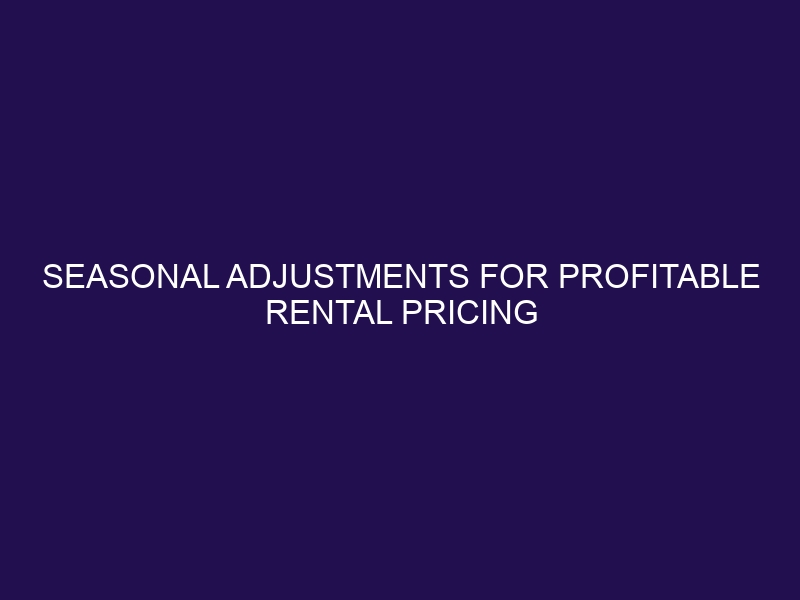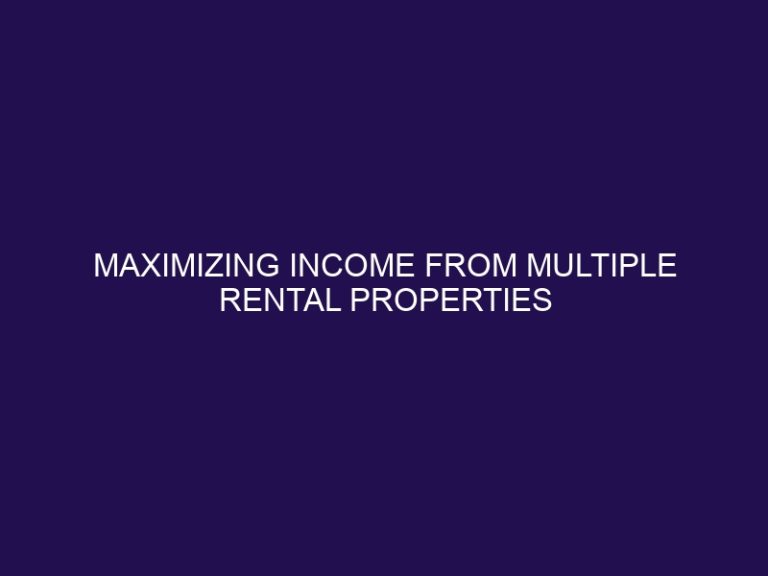Seasonal Adjustments for Profitable Rental Pricing
Seasonal adjustments for rental pricing refer to the practice of adjusting the cost of a rental property based on the time of year. This means charging higher prices during peak seasons and lowering prices during off-peak seasons.
These adjustments are crucial for successfully managing a rental property, whether it be a vacation rental, long-term rental, or short-term rental. It involves analyzing market trends, demand and supply, and historical data to determine the most profitable pricing strategy for different seasons.
Not using seasonal adjustments can lead to inaccurate pricing, missed opportunities for higher profits, and losing bookings to competitors.
To implement seasonal adjustments effectively, it is important to regularly update rental pricing, utilize dynamic pricing tools, and communicate with potential guests.
Overall, seasonal adjustments are a vital aspect of rental property management and can lead to increased profits and competitiveness in the market.
What Are Seasonal Adjustments for Rental Pricing?
What Are Seasonal Adjustments for Rental Pricing?
Seasonal adjustments for rental pricing refer to the practice of modifying rental rates based on peak demand periods. This involves increasing prices during high-demand seasons such as holidays or summer, and decreasing them during off-peak times to optimize revenue.
Why Are Seasonal Adjustments Important for Rental Pricing?
Why Are Seasonal Adjustments Important for Rental Pricing?
Seasonal adjustments are crucial for optimizing income in the rental market. By recognizing and adapting to fluctuations in demand, property owners can maximize profits during peak periods and attract tenants during slower seasons. This strategy allows for competitive pricing throughout the year, aligning with market trends and customer preferences.
How to Determine Seasonal Adjustments for Rental Pricing?
As a rental property owner, setting the right price for your property is crucial for maximizing profits. However, rental prices can vary greatly depending on the season. In this section, we will discuss the key factors to consider when determining seasonal adjustments for rental pricing. By analyzing historical data, considering market trends, and evaluating demand and supply, you can make informed decisions on adjusting rental prices throughout the year.
1. Analyze Historical Data
- Examine previous rental information, such as rates, occupancy, and demand.
- Recognize patterns and trends in different seasons to gain an understanding of peak and off-peak periods.
- Evaluate past events or local activities that may have influenced rental demand.
When analyzing historical data, it is important to consider both short-term trends and long-term patterns to gain a comprehensive understanding of rental pricing fluctuations.
2. Consider Market Trends
- Monitor local events and festivities affecting tourism.
- Check for changes in travel patterns and visitor demographics.
- Analyze data on booking lead times and length of stay.
- Consider Market Trends
3. Evaluate Demand and Supply
- Analyze current rental demand in the area, considering both peak and off-peak periods.
- Evaluate the supply of rental properties during various seasons to gain insight into market saturation.
- Assess external factors such as local events or holidays that may impact rental demand and supply.
Did you know? It is crucial to understand the dynamics of demand and supply in order to optimize rental pricing strategies.
What Are the Benefits of Using Seasonal Adjustments for Rental Pricing?
As a rental property owner, setting the right price for your property can greatly impact your profits and success in the market. One strategy that can help achieve this is using seasonal adjustments in your rental pricing. In this section, we will explore the various benefits of implementing seasonal adjustments. From maximizing profits to attracting more bookings and staying competitive in the market, seasonal adjustments can play a crucial role in the success of your rental business.
1. Maximize Profits
- Analyze current market trends to maximize profits.
- Regularly assess demand and supply for dynamic adjustments.
- Utilize dynamic pricing tools for strategic pricing decisions.
2. Attract More Bookings
- Optimize Pricing: Adjust rates based on demand peaks and lulls.
- Offer Special Deals: Provide discounts for off-peak periods to entice more bookings and attract more bookings.
- Enhance Marketing: Promote unique experiences during high-demand seasons to attract more bookings.
Pro-tip: Utilize social media and targeted ads to showcase seasonal offers and attract more bookings.
3. Stay Competitive in the Market
- Investigate competitors’ pricing strategies to stay competitive in the market.
- Identify unique selling points to differentiate offerings and stand out from competitors.
- Offer value-added services or amenities to attract and retain customers.
What Are the Risks of Not Using Seasonal Adjustments for Rental Pricing?
As a rental property owner, setting the right price for your property is crucial for maximizing profits and staying competitive in the market. However, failing to make seasonal adjustments to your rental pricing can lead to various risks. In this section, we will discuss the potential consequences of not utilizing seasonal adjustments, including missed profits, lost bookings to competitors, and inaccurate rental pricing. By understanding these risks, you can make informed decisions about your rental pricing strategy.
1. Missing Out on Potential Profits
- Regularly analyze market trends and demand-supply dynamics to avoid missing out on potential profits by adjusting pricing accordingly.
- Utilize dynamic pricing tools to adapt rates based on real-time data to maximize profits.
- Communicate with guests to understand their preferences, enabling tailored pricing strategies to increase profits.
2. Losing Bookings to Competitors
- Enhance Online Presence: Optimize property listings on booking platforms and maintain positive guest reviews.
- Competitive Pricing: Monitor competitors’ rates and adjust pricing strategically to avoid losing bookings to competitors.
- Value-added Services: Provide additional perks to attract guests, such as complimentary amenities or flexible cancellation policies.
A vacation rental owner implemented competitive pricing and saw a 20% increase in bookings within a month.
3. Inaccurate Rental Pricing
- Regularly review market trends and demand-supply dynamics to identify pricing inconsistencies.
- Utilize historical data to assess past inaccuracies and adjust pricing strategies accordingly.
- Consider implementing dynamic pricing tools to adapt to changing market conditions effectively and avoid inaccurate rental pricing.
How to Implement Seasonal Adjustments for Rental Pricing?
As a rental property owner, adjusting your pricing according to the changing seasons can significantly impact your profitability. But how exactly do you implement seasonal adjustments for rental pricing? In this section, we will discuss the three essential steps to effectively adjust your rental pricing. From regularly updating your rates to utilizing dynamic pricing tools and effectively communicating with potential guests, we will explore the best strategies for maximizing your rental profits throughout the year.
1. Update Rental Pricing Regularly
- Regularly monitor market trends and demand fluctuations to stay updated on current rental pricing.
- Analyze competitor pricing strategies to ensure competitive pricing for your rental.
- Take into consideration feedback from previous guests to make informed decisions on rental pricing.
2. Use Dynamic Pricing Tools
- Utilize dynamic pricing tools to adjust rental rates based on demand fluctuations.
- Implement software like PriceLabs for automated adjustments and to stay competitive.
- Analyze competitor pricing to stay competitive.
3. Communicate with Guests
- Ensure clear communication with guests regarding any seasonal pricing changes.
- Provide an explanation for the adjustments to help guests understand and plan accordingly.
- Offer promotional packages or loyalty discounts to encourage bookings during off-peak seasons.
Frequently Asked Questions
What is seasonal pricing and why is it important in the vacation rental market?
Seasonal pricing refers to adjusting prices based on demand during a specific season or event. It is an important factor in the vacation rental industry, especially in the current market recovering from the coronavirus pandemic. Setting the right seasonal prices in advance can greatly impact future profits and help property managers stay competitive.
How can property managers set seasonal pricing for their rental portfolio?
There are 5 easy steps property managers can follow to set seasonal pricing. They should determine their minimum and maximum rates, identify high and low demand periods, analyze historical data and trends, monitor and adjust prices regularly, and communicate the pricing strategy to potential guests.
What factors should property managers consider when setting seasonal pricing?
Property managers should consider the basic rate, occupancy rate, average rates, base rates, online travel agencies and sales channels, competition in the area, and historical data and trends. It is important to strike a balance between occupancy and profitability when setting seasonal prices.
How can property managers adjust prices in real time based on demand and competition?
Property managers can use dynamic pricing tools that utilize machine learning and AI to automatically adjust prices based on market data. They can also manually monitor demand and competition and make adjustments accordingly to maximize profits and minimize vacancy risk.
Are there any special offers or discounts that property managers can use to fill gaps in their rental bookings?
Yes, property managers can offer last minute discounts, early bird discounts, long term discounts, and shoulder season discounts to attract more bookings during low demand periods. They can also add seasons or offer special rates for particular events or festivals in the area.
How can seasonal adjustments help property managers maintain a stable cash flow?
By setting seasonal rates, property managers can ensure a steady stream of income throughout the year instead of relying on high season rates. This can help balance out any cancellations or unexpected vacancies and provide a more stable cash flow.







